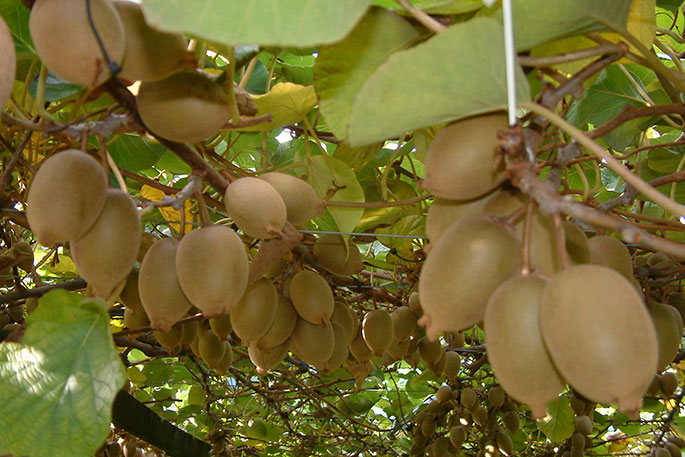With strong global demand continuing to encourage rapid expansion of New Zealand kiwifruit supply, significant investment will be required in the post-harvest segment to boost production capacity in the years ahead, says a newly-released sector report.
And with major capital expenditure necessary, kiwifruit growers are being urged to ramp up capital planning discussions with PHS providers and banks.
In the report, The Time for Capital Planning is Nigh - Funding the Expansion of New Zealand's Kiwifruit Post-Harvest Infrastructure, agribusiness banking specialist Rabobank says global demand for Zespri kiwifruit is forecast to rise to 300 million trays by 2028.
"To meet this anticipated jump in demand, the production of New Zealand-grown Zespri kiwifruit will need to increase to around 225 million trays over this period with the balance coming from Zespri's global supply program grown under licence outside of New Zealand," report author, Rabobank senior horticultural analyst Hayden Higgins says.
"This required lift in production of New Zealand-grown kiwifruit represents a 46 per cent increase on 2019 volumes, and, while the industry is currently doing everything it can to optimise existing infrastructure and expand production capacity, Zespri indicate they expect between $700 million and $750 million of capital expenditure will be required to handle 225 million trays of kiwifruit by 2028."
Hayden says both bank debt and shareholder equity would be required to fund new infrastructure.
"Fundamental to supporting this expansion will be the capacity of the PHS to borrow from banks and - given the strong recent performance of the sector over recent seasons - the sector appears well placed to do so," Hayden says.
"The PHS will also have to source equity, and our modelling suggests this will need to be more than one-third (approximately $250 million) of the forecast capital expenditure."
Hayden says kiwifruit growers have a vested interest in investing in the supply chain and were therefore the most likely source of the new equity required.
"Ultimately, growers have three alternative paths they can take with regard to funding the new equity needed for PHS infrastructure," he says.
"Firstly, they could choose to directly invest and become shareholders of post-harvest operations and fund this from their own orchard operations. Secondly, they could choose not to invest but potentially pay an increased packing charge to support a dividend stream suitable to non-grower investors. And finally, they may end up with a combination of the two."
With these options in front of them, growers should be looking to engage with industry participants to plan for this future funding requirement, Hayden says.
"Communication of strategy between growers and the post-harvest segment will be essential and growers should be engaging with their PHS providers to understand their plans to participate in the infrastructure expansion, how they expect this will be funded and their options for participation.
"Communication with financiers will also be essential. Banks will want to understand a grower's strategy and if it includes expanding production and owning shares or even owning shares without expanding production."
Other potential sources of equity
The reports says, in theory, growers could fund all required equity, but it was unlikely all growers would participate.
"Our analysis indicates growers could potentially afford to fund the total pool of equity required, and we've already seen a number of growers committing to supporting expansion by buying shares and committing supply," he says.
"However, some growers will likely choose not to, possibly to avoid having all their investment eggs in one basket or because they'd prefer to invest in productive assets versus shares that they may be unable to use as security."
With additional equity likely to be required, the report says non-grower investors and corporate investors shape as alternative sources of funding.
"Non-grower investors are considered likely to show interest in the sector. Especially in the current economic climate when asset yields have lowered,” Hayden says.
"This group of investors, which could include retired growers, may find the profile of a primary sector investment with a strong future outlook attractive."
Hayden says pre-Covid-19, corporate investors or investment funds were considered the third - though least likely - source of potential equity for post-harvest expansion.
However, the impact of the coronavirus pandemic on investment opportunities may have improved the likelihood of interest among this form of investors.
"There are a number of reasons why participation from this type of investor is less likely, including traditionally high hurdle rates (minimum rate of return) for this form of investor, equity requirements of individual post-harvest segment operators falling short of capital placement hurdles and potential Overseas Investment Act restrictions," he says.
"However, with the arrival of Covid-19, some of these barriers or perceived barriers to participation may be less relevant, particularly in relation to return hurdles which have come down in the Covid-19 environment."
PHS competition set to rise
The report says each business in the post-harvest sector will have a different strategy when it comes to industry expansion, ranging from non-participation through to significant expansion.
"Each PHS business will have a different appetite for debt and financial ability to expand and subsequently repay debt, and, on this basis, the opportunity will fall either to the incumbents who do have the capacity to grow, or to new entrants.
"Businesses that elect to maintain the status quo capacity will plan to keep their existing suppliers, but will likely face increased competition from those looking to expand or from new entrants seeking to procure supply. New entrants - especially if they have little or no experience - will also create competition for skilled employees within the sector."



0 comments
Leave a Comment
You must be logged in to make a comment.